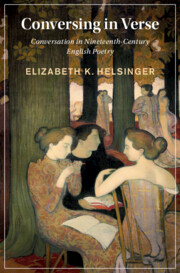Book contents
- Conversing in Verse
- Cambridge Studies in Nineteenth-Century Literature and Culture
- Conversing in Verse
- Copyright page
- Contents
- Figures
- Acknowledgments
- Chapter 1 Introduction: A Poetics of Encounter
- Chapter 2 Dialogue and the Idyll: Tennyson and Landor
- Chapter 3 Performing Conversation: Swinburne and Robert Browning
- Chapter 4 Projects of Animation: Coleridge and Clare
- Chapter 5 Ecphrastic Questions: Dante Gabriel Rossetti and Michael Field
- Chapter 6 Cruel Intimacies: Christina Rossetti and Thomas Hardy
- Epilogue
- Notes
- Bibliography
- Index
- Cambridge Studies in Nineteenth-Century Literature and Culture
Chapter 3 - Performing Conversation: Swinburne and Robert Browning
Published online by Cambridge University Press: 21 July 2022
- Conversing in Verse
- Cambridge Studies in Nineteenth-Century Literature and Culture
- Conversing in Verse
- Copyright page
- Contents
- Figures
- Acknowledgments
- Chapter 1 Introduction: A Poetics of Encounter
- Chapter 2 Dialogue and the Idyll: Tennyson and Landor
- Chapter 3 Performing Conversation: Swinburne and Robert Browning
- Chapter 4 Projects of Animation: Coleridge and Clare
- Chapter 5 Ecphrastic Questions: Dante Gabriel Rossetti and Michael Field
- Chapter 6 Cruel Intimacies: Christina Rossetti and Thomas Hardy
- Epilogue
- Notes
- Bibliography
- Index
- Cambridge Studies in Nineteenth-Century Literature and Culture
Summary
Chapter 3, like Chapter 2, discusses poetry where conversation is both a represented and an experiential event – but as a represented event, one marked by swerves, interruptions, and misprisions such as those Blanchot believed essential to honor the otherness of others. Performing conversation in print, Swinburne and Browning drew on the long dramatic speeches, the formal stichomythic exchanges, and the dialogues between communal chorus and heroic characters that both admired in classical Greek tragedy. The chapter argues that the verse dramas and dramatic monologues of the later poets attempted a reparative political work under conditions of conversational asymmetry. For both Swinburne and Browning, as later for Levinas and Blanchot, the often missed exchanges of dramatic speech, especially in its tense relations with lyric or choral song, offered a site where readers not only study but also experience the difficulty of meaningful exchanges with the autonomous, enigmatic, but also authoritative otherness of the human and non-human world.
- Type
- Chapter
- Information
- Conversing in VerseConversation in Nineteenth-Century English Poetry, pp. 55 - 89Publisher: Cambridge University PressPrint publication year: 2022

